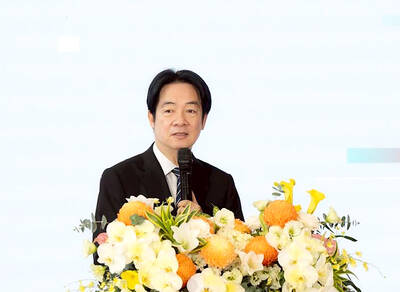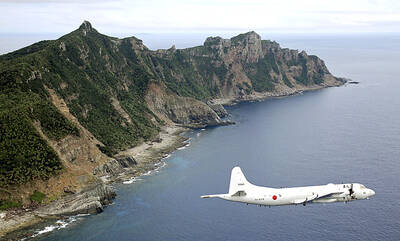The Ministry of National Defense (MND) yesterday said it had deployed joint intelligence, surveillance and reconnaissance assets to track the movements of China’s third aircraft carrier, the Fujian, as it transited the Taiwan Strait en route to the South China Sea.
The military said the measures were taken to “maintain full awareness” of the carrier’s movements, and it had “responded appropriately.”
The Japanese Ministry of Defense first disclosed the Fujian’s passage on Thursday, reporting that its Maritime Self-Defense Force sighted the vessel at about 1pm sailing southwest in waters about 200km northwest of the Diaoyutai Islands (釣魚台), known in Japan as the Senkaku Islands.

Photo: AFP
The carrier was accompanied by the guided-missile destroyers Hangzhou and Jinan, the Japanese Joint Staff Office said.
China’s state-run Xinhua news agency later confirmed the transit, saying the Fujian was headed to the South China Sea to “carry out scientific research tests and training missions.”
Citing Chinese People’s Liberation Army (PLA) spokesman and senior Captain Leng Guowei (冷國偉), the report said the tests and training were “not aimed at any specific target,” but regular arrangements in the carrier’s construction process.
The sailing coincided with joint exercises in Okinawa, where US Marines and Japanese forces are conducting a two-week drill featuring the Typhon missile system and other advanced anti-ship weapons, scheduled to run until Sept. 25.
A senior Taiwanese security official said that the Fujian was likely bound for the South China Sea in preparation for its commissioning ceremony.
First unveiled in 2022, the Fujian is China’s third aircraft carrier and began sea trials last year. It has not yet formally entered service. Designed and built domestically, it is larger and more advanced than the Shandong, commissioned in 2019, and the Liaoning, purchased second-hand from Ukraine in 1998.
With a flat deck and electromagnetic catapults, the Fujian is expected to host a broader range of aircraft than China’s other carriers — including early-warning planes and, eventually, the country’s first carrier-based stealth fighters.
The transit through the sensitive Taiwan Strait was intended to signal “China’s rise as a strong military power, and beyond that, a maritime great power,” said Collin Koh (許瑞麟), a senior fellow at the S. Rajaratnam School of International Studies in Singapore.
“It’s to flex China’s newfound military strength and send a veritable signal to potential adversaries,” he said.
Regional security analysts and military attaches are watching the Fujian’s trials closely, particularly for signs of how effectively the PLA Navy can integrate carrier operations with escort ships and submarines.
Beijing has poured billions of dollars into modernizing its armed forces in recent years, a buildup that has unsettled regional governments even as China insists its intentions are peaceful. The South China Sea has become a focal point of Chinese military activity, with Beijing asserting expansive territorial claims disputed by the Philippines, Vietnam and other nations.
In June, Beijing announced that the Liaoning and Shandong carrier groups had conducted combat drills in the western Pacific, drawing concern from Japan and other neighbors.
A Taiwanese security official said the following month that both carrier groups had been deployed around the nation in May.

MISINFORMATION: The generated content tends to adopt China’s official stance, such as ‘Taiwan is currently governed by the Chinese central government,’ the NSB said Five China-developed artificial intelligence (AI) language models exhibit cybersecurity risks and content biases, an inspection conducted by the National Security Bureau (NSB) showed. The five AI tools are: DeepSeek, Doubao (豆包), Yiyan (文心一言), Tongyi (通義千問) and Yuanbao (騰訊元寶), the bureau said, advising people to remain vigilant to protect personal data privacy and corporate business secrets. The NSB said it, in accordance with the National Intelligence Services Act (國家情報工作法), has reviewed international cybersecurity reports and intelligence, and coordinated with the Ministry of Justice Investigation Bureau and the National Police Agency’s Criminal Investigation Bureau to conduct an inspection of China-made AI language

LIMITS: While China increases military pressure on Taiwan and expands its use of cognitive warfare, it is unwilling to target tech supply chains, the report said US and Taiwan military officials have warned that the Chinese People’s Liberation Army (PLA) could implement a blockade within “a matter of hours” and need only “minimal conversion time” prior to an attack on Taiwan, a report released on Tuesday by the US Senate’s China Economic and Security Review Commission said. “While there is no indication that China is planning an imminent attack, the United States and its allies and partners can no longer assume that a Taiwan contingency is a distant possibility for which they would have ample time to prepare,” it said. The commission made the comments in its annual

‘TROUBLEMAKER’: Most countries believe that it is China — rather than Taiwan — that is undermining regional peace and stability with its coercive tactics, the president said China should restrain itself and refrain from being a troublemaker that sabotages peace and stability in the Indo-Pacific region, President William Lai (賴清德) said yesterday. Lai made the remarks after China Coast Guard vessels sailed into disputed waters off the Senkaku Islands — known as the Diaoyutai Islands (釣魚台) in Taiwan — following a remark Japanese Prime Minister Sanae Takaichi made regarding Taiwan. Takaichi during a parliamentary session on Nov. 7 said that a “Taiwan contingency” involving a Chinese naval blockade could qualify as a “survival-threatening situation” for Japan, and trigger Tokyo’s deployment of its military for defense. Asked about the escalating tensions

DISPUTE: A Chinese official prompted a formal protest from Tokyo by saying that ‘the dirty head that sticks itself out must be cut off,’ after Takaichi’s Taiwan remarks Four armed China Coast Guard vessels yesterday morning sailed through disputed waters controlled by Japan, amid a diplomatic spat following Japanese Prime Minister Sanae Takaichi’s comments on Taiwan. The four ships sailed around the Senkaku Islands — known as the Diaoyutai Islands (釣魚台) to Taiwan, and which Taiwan and China also claim — on Saturday before entering Japanese waters yesterday and left, the Japan Coast Guard said. The China Coast Guard said in a statement that it carried out a “rights enforcement patrol” through the waters and that it was a lawful operation. As of the end of last month,